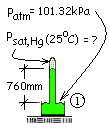| THERMO Spoken Here! ~ J. Pohl © | TOC NEXT ~ 82 |

Pressure of the Void
To high precision, standard atmospheric pressure equals 101.32 kPa and will support a barometric column of mercury 760 millimeters in height. These numbers are defined to be (assumed as) the surface-of-Earth average.
Torricelli assumed the void at the top of the column of a mercury barometer to be "vacuum." He also assumed vacuum meant numerically zero pressure. The actual, non-zero pressure, "in the void" of a mercury barometer is called the vapor pressure of mercury at the prevailing temperature. Use the information of the sketch.
Calculate the "Pressure of the Void."
♦ Application of the hydrostatic equation must commence at a location where the pressure is known. The atmospheric pressure, at the air/mercury interface, is 101.32 kPa. Since the interface is flat, the pressure there "in air" is the same as the pressure there "in mercury." Pressure does not change "across" the interface.
patm = 101,320 Pa and p1,Hg = 101,320 Pa
The pressure of the mercury gas (trapped above and seen as a "void") at a height of 760 mm above the air/mercury interface is less than 101,320 Pa by the pressure difference:
ρHggo(760 mm)
The density of liquid mercury is 13,594.58 kg/cubic meter (great precision must be carried because this calculation entails both very large and very small numbers).
patm - ρHggo(760 mm) = pHg,vapor
Entering numbers, we have:
101,320 N/m2 - (13,594.58 kg/m3)(9.80 m/s2)(0.760 m) = pHg,vapor
Running the numbers yields:
27 Pascals = pHg,vapor
This example, correct in principle, is subject to error because some numbers of the calculation are very large while other numbers are very small.
Pressure of the Void

To high precision, standard atmospheric pressure equals 101.32 kPa and will support a barometric column of mercury 760 millimeters in height. These numbers are defined to be (assumed as) the surface-of-Earth average.
Torricelli assumed the void at the top of the column of a mercury barometer to be "vacuum." He also assumed vacuum meant numerically zero pressure. The actual, non-zero pressure, "in the void" of a mercury barometer is called the vapor pressure of mercury at the prevailing temperature. Use the information of the sketch. Calculate the "Pressure of the Void."
Premise presently unwritted!